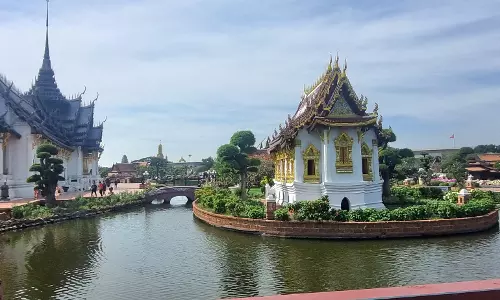Documentary navigates journey of ‘dhaak’ artistes
Conventional or unconventional, a subject needs to be drawn from a different angle, notes talented documentary filmmaker Gautam, whose latest project Dhaak Katha navigates the journey of humble dhaak;

Conventional or unconventional, a subject needs to be drawn from a different angle, notes talented documentary filmmaker Gautam, whose latest project Dhaak Katha navigates the journey of humble dhaak (ethnic Bengali drum) artistes from Bengal, who always remained the unsung heroes on the region’s evolving musicscape. In sync with the upcoming Puja fervour, this unconventional subject has played an ideal fodder for the project. Briefing his encountering while shooting the 30-minute flick, the director shares: “Only two months ago, Dwaipayan Das, the marketing manager of Mysore-based manufacturer Cycle Pure Agarbathies had approached me with this exciting offer to usher in the decade-long sojourn of dhaak music that the company has been promoting and patronising since 2004. I instantly opted for the docu-format as I’m more comfortable in the medium. So I felt, the output ought to be a real one and not a typically sponsored corporate docu-film. Since cinema is primarily a visual platform, so my sole condition was to talk less and show more.” Steeped in with theatrical, fictional elements inside a non-fiction premise, the plotline trails the lifestory of two nondescript dhaak players, scripting their rise to success from a scratch. “Right at the beginning, there’s this beautiful extreme long shot taken to depict a dhaaki being followed by an army of little children tapering out with the magnetic attraction of the throbbing drum-beats. This scene is a direct allusion to the fabled solitary figure of the legendary Pied Piper of Hamelin, who drove out all the rats alongwith small kids from the town. It goes without saying that this is my favourite shot,” he reveals. The idea was to document the revival of 3,000 years-old dhaak as a performing artform in the contemporary era of electronic music. Lucidly capturing this instrumental craft on the 70 mm celluloid, Gautam lodges his touch of finesse in his carefully etched out work. Shot at various locations between the Murhsidabad district and Kolkata, the man wielding the megaphone says that “it was highly important to retain the rustic roots from where the dhaakis originate. Hence, the pastoral village scene of Murshidabad’s Beldanga village was filmed with the dhaak players being shown as farmers, gradually losing charm in their musical craft owing to monetary crisis and dearth of publicity. They decide to disown the paternal art before being catapulted to reclaim their recognition amidst much fanfare. We had brainstormed on the theme only three months ago and wrapped up with the shoots by this August-end. It has been a fulfillingly enjoyable experience to say the least.” Narrating an interesting trivia, the 30-something cerebral maker with a vision rattles of: “Barely a couple of days ago, a close friend of mine had buzzed me from far San Francisco and when I chanted him out the rhythmic refrain of the dhaak beats in Bengali — dhankurkur dhankurakur — over the phone, he could then instantly guess the instrument’s name and was straightaway ridden on a flashback mode to his innocent childhood years. The fond memories of the Durga Puja alongwith its dhaak-beats, the priest’s aarti, earthen lamps and the fragrance of incense sticks came rushing in. His voice choked with emotions, and so did mine. My eyes too had welled up with the hint of nostalgia. You see, there is an aura of sentiment surrounding this indigenous folk instrument from the hinterlands of Bengal.” Next, the helmer plans to reel an endeavour on Gurudev Rabindranath Tagore and the influence of baul (a folk genre of Bengal) music on him. “History has it that the bard had travelled to Germany in the year 1933, carrying the essence of baul philosophy into his writings there. On one had, we talk about the impact of Scottish tunes in Tagore’s songs and the borrowings of Bharatanatyam steps and Manipuri mudras in Rabindrik danceform. But we seldom hinge on his inspiration derived from the bunch of vagabond musicmen like the earthy bauls,” he avers. The documentary will be funded by Aniruddha Ghosh, an NRI nuclear-scientist producer. Already tried his hand at a slew of TV series, Gautam sounds pretty conversant with the small-screen space. Originally a theatre actor-director of a group called Dream Theatre, which is no longer existent, this dynamic creative personality observes that “it’s utterly difficult to be a full-fledged theatre-practitioner these days, since both time and finance are found to be a scarce companion in this domain.” However, Dream Theatre in its hey-days had staged a host of thought-provoking productions like Godor Pratikshay, the Bengali version of the noted Irish literary polymath Samuel Beckett’s seminal work of drama, Waiting for Godot. “We have also co-ordinated with Kaushik Sen’s theatre troupe Sapnasandhani and Chandan Sen’s Theatron. Both are accomplished young directors of the current-day theatre-community of Kolkata,” he informs. Having assisted the popular realistic Bengali filmmaker Anjan Dutt in his last four assignments, Gautam will now descend as the casting director for a forthcoming venture titled, Kolkatar King Company. It is the cinematic version of The Threepenny Opera, a very well-known musical by the great 20th century German dramatist Bertolt Brecht and composer Kurt Weill. The movie will be directed by Judhajit Sarkar, whose first outing was Khashi Katha (based on women boxers), still awaiting a release. To the uninitiated, the piece was also much earlier, scripted for the Bengali stage by noted actor-thespian Ajitesh Bandopadhyay and christened as the legendary play, Teen Poisar Pala.


